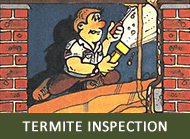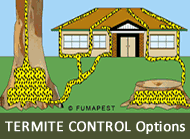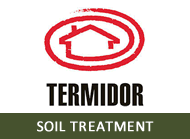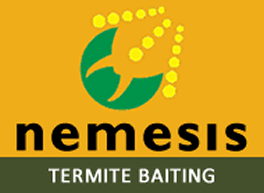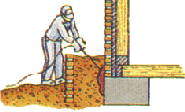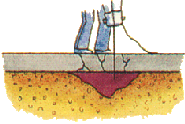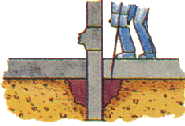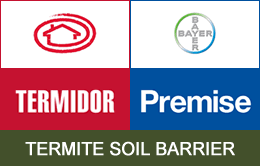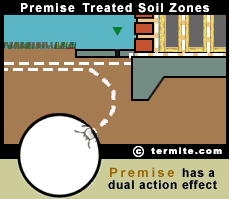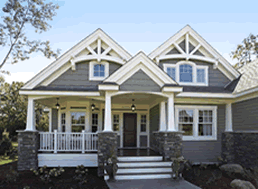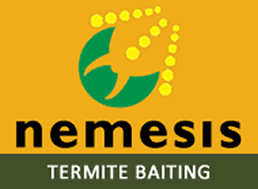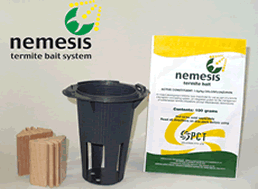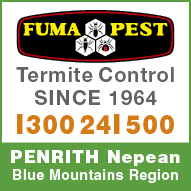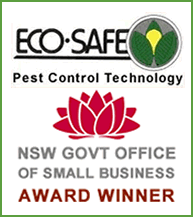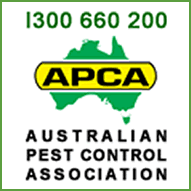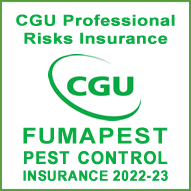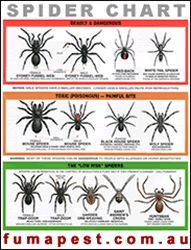| Summary of your Termite Control options ✦ updated |
| AS:3660 Termite Inspection & Report ✦ Australian Standard 3660 |
| A Termite Inspection & Report involves a thorough
inspection of the buildings and surrounds ✦ a written inspection report on evidence found of termites and termite activity ✦ details of any high risk termite entry points that are inacccessible to inspection ✦ and specifications to AS:3660 for
an integrated termite control program ✦ the inspection
and report should be received and considered in detail before any protective measures are commenced.
The cost of a Termite Inspection Report to AS:3660 is approx $300 for an average size home ✦ depending upon size and style of construction ✦ ease of inspection access ✦ and the time involved in conducting a proper inspection. |
|
 |
Specific areas inspected include all accessible timbers within the crawl space in the sub-floor ✦ roof void area ✦ interior ✦ exterior ✦ garden landscaping ✦ fences ✦ and where practicable any other timber structures and trees within a 50 metre radius of the buiklding.
Termatrac termite detection equipment is used where we know or suspect that a termite sub-nest is present inside the wall cavities of the building. |
|||
| Treated Soil Barriers to AS:3660 ✦ Chemical Soil Treatments |
| Home Insurance does NOT cover termite damage to structural or other timbers inside a building, which could be severe ✦ the replacement cost of termite infested structural timbers in the roof and wall may exceed $50,000.
FUMAPEST has Professional indemnity insurance to cover future termite damage to structural and decorative timbers in a building after we have carried out a complete TERMIDOR soil treatment service to AS:3660 ✦ FUMAPEST highly recommends the use of TERMIDOR Soil Treatrment Termiticide as the most effective termite protection product commercially available in Australia. Termites in the Building at the time of AS:3660 Soil Treatrment ✦ cannot safely return to their central colony nest through the chemically treated soil ✦ termites usually need to return every few days to their central underground nest to obtain moisture essential for their survival and to feed and groom other termites ✦ the king ✦ queen ✦ reproductives ✦ soldiers ✦ young nymphs. Expert Knowledge and specialised equipment is required to form a complete and continuous barrier arund the building in order to to protect the building from a termite entry and infestation ✦ as illustrated below: |
|
||||||||||||||
|
|
||||||
| Pesticide Safety Issues ✦ Soil Treatment Termiticides |
Termite Control Chemicals are required to be assessed and approved by Federal Govt APVMA ✦ for example ✦ approved termiticides include ✦ Termidor ✦ Premise. Some approved termiticides include an organo-phosphate pesticide emulsified with xylene a solvent based chemical.
Solvent based termiticides are NOT used by FUMAPEST even though they are much cheaper. Solvent based termiticides are known in certain circumstances to cause health problems for people with asthmatic or bronchial ailments. We recommend Termidor for safety and long term effectiveness. Water based ✦ Termidor and Premise are water based ✦ with virtually no smell and of ultra-low hazard to humans, dogs, cats and other mammals. No fumes whatsoever ✦ Termidor and Premise do NOT have an obnoxious odour or emit airborne residues or fumes. Both are registered by Federal Govt APVMA as a low hazard insecticide with a CAUTION notation on the registered label. Termidor is manufactured by BASF and Premise by Bayer. Fipronil the active ingredient in Termidor is also used in Frontline the flea and tick control product used on millions of cats and dogs in Australia and the USA, without any health issues arising. Non-repellant Termiticides ✦ Termidor and Premise are much more certain and effective, in that the termites cannot avoid what they cannot detect ✦ the chemical adheres to the skin of the worker termites or they ingest it when tunneling through treated soil areas. Termidor & Premise ✦ exhibit a delayed lethal effect on affected termites of several days ✦ enough time for the fipronil chemical to be spread around the colony nest by the termites mutual feeding and grooming habit ✦ with sufficient consumption of the chemical, the entire colony is eliminated. Scientifically Proven ✦ Termidor and Premise are scientifically proven as being readily transferred from one affected termite to another ✦ the technology is aimed at eradicating the entire colony ✦ the mode of action is illustrated below. FUMAPEST provides a 5 Year FREE Service Period for a complete Termidor Soil Treatment to AS:3660 ✦ subject to annual inspection regime ✦ Termidor Treatment Cost is usually between $3,500 to $6,000. |
|
|
|||||||
| Termite Baits ✦Termite Baiting Systems ✦ Benefits & Limitations |
|
|||||||
Termite Baits registered in Australia by Federal Govt APVMA include Nemesis - Exterra - Sentricon termite baits.
Regular monitoring is required ✦ the use of Termite Baits must be subject to regular inspection and monitoring by the termite controller ✦ the more termite bait consumed, the quicker and more certain is the termite colony elimination process. FUMAPEST Policy is to attach the NEMESIS termite bait directly over known live termite activity areas ✦ the rate and amount of consumption is monitored for several weeks ✦ and if practicable thereafter, a complete chemical soil barrier treatment using Termidor Termiticide be applied around the perimeter of the building and other high risk entry points. Termite Baiting needs Expertise ✦ Be Careful ✦ to be effective the termites need to find the stations, infest the timber therein and then termite bait is added ✦ termites travel in underground tunnels ✦ are more likely to enter your home ✦ a far bigger food source. Termite baiting needs skill and expertise. Termites have acute survival instincts ✦ too much disturbance of the foraging termites (workers and soldiers) in a particular location, this may well alert the termite colony to abandon the immediate area ✦ they appear to be gone, but may be entering the building in other areas inaccessible to inspection ✦ It is often difficult to be confident the termite colony has in fact been eradicated. Termite Baiting ✦ Termite colony elimination in favourable circumstances may take several weeks to a few months ✦ in some cases, termite colony elimination is unsuccessful or may take years. It depends if sufficient termite bait is consumed by a large number of termites ✦ then colony elimination is virtually assured within a few months ✦ the experience and skill of the pest controller is paramount, in order to properly decide if and where a baiting program is to be implemented and properly monitored. Proper Termite Baiting can be Expensive as it is usual to reinspect the bait stations, the building and surrounds every month to reposition, reapply or replenish the termite bait ✦ this process is labour intensive so the long term cost of monitoring and baiting system may accumulate out of hand before the chance of success or otherwise, is realised. Consumer note ✦ some pest controllers offer termite baiting at ridiculously low prices that does not cover direct materials and labour ✦ they collect all the money upfront for future inspections ✦ and dissappear ✦ or they fail to advise that a Termite Preventive Barrier to AS:3660 is the best long term option ✦ BEWARE the NSW Govt EPA Pest Control Licensing system in NSW is inadequate✦ Some individuals have a NSW Pest Control Licence with little training or experience ... more details below. |
| Ring the Experts: Dont bet your house on a DIY Termite Control Solution ✦ successful termite protection of a building using a baiting program requires expert skill and judgment, based on more than 55 years of field-work experience in termite control in a wide variety of circumstances.
Live termites found? ✦ Remember ✦ one critical aspect is that the bait stations only be to installed in areas where live activity is found ✦ otherwise the termites must blindly "find" the stations to have any chance of widespread termite bait consumption and successful termite colony elimination. |
|
An Integrated Approach: A termite baiting program should be part of range of options including ✦ drilling susceptible trees and eradication of any termite nest located therein, and ✦ follow up chemical soil treatment using Termidor or Premise. |
||||||||
|
|||||||||
| Advice to Home Owner on Termite Risk Reduction |
|
Listed below are some useful recommendations for the home-owner to carry out in order to help reduce the risk of undetected termite activity inside a building.
Rapid termite colony development and building infestation is usually associated with a readily available timber food and moisture source nearby the central nest. Buildings are often constructed in a way that allow termites to gain undetectable entry from the soil to the structural timbers of the building. (1) Moisture exclusion from inside the wall cavities, around the base of the building and sub-floor area. Excessive water run-off from a sub-floor area can be remedied by the installation of ag-drains. It is also important to ensure adequate cross flow ventilation in the sub-floor area. A qualified plumber should ensure there is no water leakage from plumbing pipes in bathroom, shower recess, kitchen, down pipes, guttering and air conditioning overflow. Look for dampness in wall cavities, broken roof tiles, faulty guttering and the like. Hiigh humidity, dampness or moisture accumulating in a wall cavity encourages large scale termite activity inside the building. (2) Removal of any timber in contact with the soil. Timbers should be stored above ground level to allow full inspection for termite activity. Any landscaping using timber chip mulch and railway sleepers should be removed, as they provide ready food source to assist in rapid termite colony development. (3) Ensure inspection access is unimpeded, particularly in sub-floor areas of suspended floors, in order to look for evidence of termite activity. If your home is on concrete slab on-ground flooring, make sure you can inspect the entire external slab edge for evidence of termite mud-shelter tubes. Do NOT allow this area to be covered by pavers, landscaping, planter pots, etc, as termites often gain entry into the wall cavity through external weep holes and gaps in the mortar of brick-work. If you find live termites DO NOT disturb the area. DO NOT use spray insecticides on the termites. If sufficiently disturbed, the termites may move elsewhere and not be rediscovered until severe damage has been done. The termite controller can install a termite bait on the termite activity area to maximise bait consumption by the termites and elimination of the entire colony. |
|||
| Regular follow-up Termite Inspection & Monitoring |
FUMAPEST Professional Indemnity Insurance covers subsequent termite damage provided a complete soil treatment and follow-up inspections are carried out to AS:3660. Don't Risk - DIY Termite Control ✦ this is a job for the professionals ✦ the correct identification of destructive termite species ✦ inspection of a building for tell-tale signs ✦ analysis of your circumstances ✦ the design and implementation of an effective program to protect a building from termite infestations ✦ requires expert skill and judgment gained from professional training and extensive field-work experience in termite control in a wide variety of circumstances. |
||||||
| . |
| Authoritative PDF Articles ✦ Termites & Termite Control Services |
| Australian Termite Identification PDF ✦ Australian Govt AQIS Publication
Builders Guide to Termite Management PDF 2004 ✦ Master Builders Qld Protect Your Home from Termites 2003 PDF ✦ NSW Govt Dept of Fair Trading Protect Buildings from Subterranean Termites 2006 PDF ✦ Timber Qld Ltd TERMIDOR Termite Control Soil Treatment Product PDF ✦ BASF Australia Ltd Termites in New South Wales 2005 PDF ✦ NSW Govt Dept of Primary Industries Termite Risk Management PDF ✦ Aust Govt Forest & Wood Products Research Termite Incidence Survey & Hazard Map 2002 PDF ✦ CSIRO & FWPRDC Research Termite Management Systems 2010 PDF ✦ Building Services Authority Qld Termite Control & Termiticide Health Hazards 2004 PDF ✦ Aust Govt Dept of Health Termite Baits & Termite Control in Buildings 2009 PDF ✦ Qld Govt Publication Subterranean Termites & Protection of Buildings 2009 PDF ✦ Qld Govt Publication Subterranean Termite Infestation in Buildings 2009 PDF ✦ Qld Govt Publication Urban Australian Cities under Termite Attack PDF ✦ University of Qld et al Drywood Termites & Termite Control in Buildings 2009 PDF ✦ Qld Govt Publication West Indian Drywood Termites 2008 PDF ✦ NSW Govt Dept of Primary Industries Subterranean Termite Treatment Options PDF ✦ Virginia University, 2010 Termite Management for Home Owners PDF ✦ University of Arizona |
||
| WARNING: The NSW Govt EPA Pest Control Licensing is INADEQUATE |
| Be Careful in selecting a Pest Controller ✦ Unfortunately ✦ it is far too easy to get a NSW Govt EPA issued pest control licence and start up a Pest Control business in NSW with little knowledge or experience in providing pest control services ✦ click here for more details. | ||
